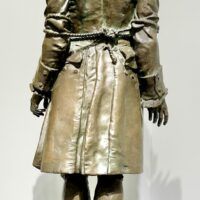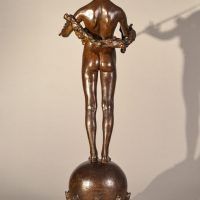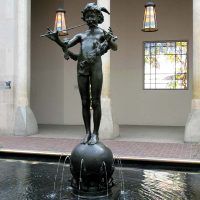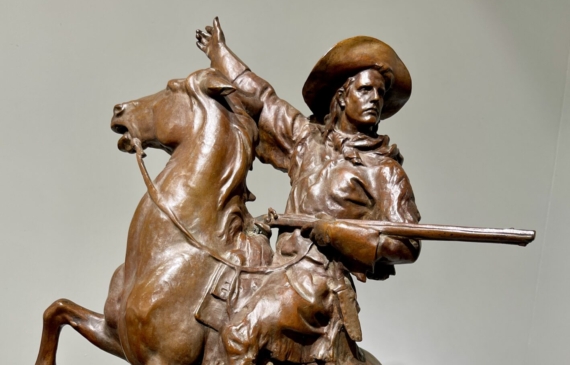






Frederick W. MacMonnies
(American, 1863-1937)
Nathan Hale, 1890
Bronze, brown patina, 28 ¼ H. inches
Signed on the base: F. MacMonnies 1890
Foundry stamp on base: E. Gruet Juene, Paris





Frederick W. MacMonnies
(American, 1863-1937)
Young Faun with Heron, 1889-1890
Bronze, 28 H. inches
Signed and dated on the base:
Jaboeuf & Rouard Foundry, Paris

Frederick W. MacMonnies
(American, 1863-1937)
Diana, 1890
Bronze, brown patina
19 H. x 9 ½ W. x 12 D. inches
Signed and dated on base: Frederick MacMonnies 1890 / Copyright 1894
Stamped by JABEOUF & ROUARD FONDEURS PARIS






Frederick W. MacMonnies
(American, 1863-1937)
Pioneer Mother, 1907-1911 (reduction)
Pioneer Monument; Pioneer Memorial Fountain, Denver, Colorado
Bronze, dark green and brown patina
14 ½ H. x 20 ½ W. x 9 ¾ D. inches
36.8 H. x 52.1 W. x 24.8 D. centimeters
Signed right rear base: F.MACMONNiES
Stamped rear base: JABOEUF & ROUARD/FONDEURS A PARIS








Frederick W. MacMonnies
(American, 1863-1937)
Pan of Rohallion, 1890
Bronze, brown patina
38 ¼ H. x 12 ⅜ W. x 14 ½ D. inches
Inscribed on base: ROMAN BRONZE WORKS N – Y –
Titled on base:
TO PAN OF ROHALLION ANNO DOMINI MDCCCLXL
Cast as a fountain model

Frederick W. MacMonnies
(American, 1863-1937)
Bacchante and Infant Faun, 1893
Bronze, dark brown patina
16 H. x 5 W. x 8 D. inches
Signed on base: F. MacMonnies / 1893
Inscribed on base: H. Rouard Fondeur (Paris)
This casting is the rare reduction, of the more common larger scale 30″ high “Bacchante and Infant Faun”, 1893 by MacMonnies. This smaller size, 16 inches in height, was executed in a very limited edition at the H. Rouard Foundry in Paris, likely prior to 1900. This is a fine sand cast with the artists signature inscribed in the original wax model. The patina is the original beautiful dark brown color.
The subject model of the “Bacchante and Infant Faun” has an interesting story behind it in the lore of New York and Boston art history. the large outdoor model of this subject, 83 inches, was offered to the Boston Public Library in 1896 by the architect Charles F. McKim, for placement in the Library’s garden court. After a great storm of public protest stirred up by the Women’s Christian Temperance Union against its “drunken indecency”, the gift was rejected by the Library. McKim then presented the bronze to the Metropolitan Museum of Art, where it is on display in the Charles Engelhard Court, in the American Art Wing.




Frederick W. MacMonnies
(American, 1863-1937)
Kit Carson: Pioneer Monument, 1911
Bronze, brown patina
24 ½ H. x 16 W. x 8 ¾ D. inches
Signed on base: F. MAC MONNIES
Inscribed on base: ROMAN BRONZE WORKS INC N – Y –
Frederick William MacMonnies (September 28, 1863 – March 22, 1937) was the best known expatriate American sculptor of the Beaux-Arts school, as successful and lauded in France as he was in the United States. He was also a highly accomplished painter and portraitist.
He was born in Brooklyn Heights, Brooklyn, New York and died in New York City.
Three of MacMonnies’ best-known sculptures are Nathan Hale, Bacchante and Infant Faun, and Diana.
In 1880 MacMonnies began an apprenticeship under Augustus Saint-Gaudens, and was soon promoted to studio assistant, beginning his lifelong friendship with the acclaimed sculptor. MacMonnies studied at night with the National Academy of Design and The Art Students League of New York. In Saint-Gaudens’ studio, he met Stanford White, who was turning to Saint-Gaudens for the prominent sculptures required for his architecture.
In 1884 MacMonnies traveled to Paris to study sculpture at the École des Beaux-Arts, twice winning the highest award given to foreign students. In 1888 he opened a studio in Paris and began to create some of his most famous sculptures, which he submitted annually to the Paris Salon. In his atelier, he mentored such notable artists as Janet Scudder and Mary Foote. He was taught at the Académie Vitti in 1904.